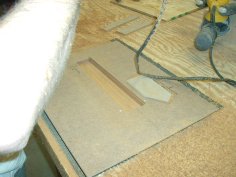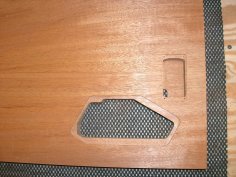|
Brian's Guitar from Conception to Birth
or How to Build a Guitar in 62 Easy Steps! |
|
5
Rout the Back Body Panel |
 Now
that youíre thoroughly prepared with your templates, itís time to
start on the real thing. The neck on our design is sandwiched in
between the top and bottom body panels. So we have to make some room
for it by routing out a cavity in the back body panel. Index the
template onto the dowels for perfect alignment, set up the router
(in this case I used a 1/2" bit with a 5/8" bushing), and let the
chips fly. Remember to set your final depth carefully on your router
so you donít cut too deep. In the photo youíll notice another small
scrap of MDF in the control cavity space on the template. Thatís
just to give the router base some support so it doesnít tilt when
riding over the thin strip between the template openings. Now
that youíre thoroughly prepared with your templates, itís time to
start on the real thing. The neck on our design is sandwiched in
between the top and bottom body panels. So we have to make some room
for it by routing out a cavity in the back body panel. Index the
template onto the dowels for perfect alignment, set up the router
(in this case I used a 1/2" bit with a 5/8" bushing), and let the
chips fly. Remember to set your final depth carefully on your router
so you donít cut too deep. In the photo youíll notice another small
scrap of MDF in the control cavity space on the template. Thatís
just to give the router base some support so it doesnít tilt when
riding over the thin strip between the template openings. |
  Next
up is the wire channels. Using the same router setup (only adjusting
the final depth), cut the wire channels. The control cavity is cut
all the way through the back body panel. Itís easiest to hog out the
majority of the material by drilling through with a large forstner
bit. To avoid blowing out and splintering the bottom, place masking
tape at that area and drill onto a solid surface like a scrap piece
of plywood. Now index the control cavity template onto the dowels
and clean up the edges. Next
up is the wire channels. Using the same router setup (only adjusting
the final depth), cut the wire channels. The control cavity is cut
all the way through the back body panel. Itís easiest to hog out the
majority of the material by drilling through with a large forstner
bit. To avoid blowing out and splintering the bottom, place masking
tape at that area and drill onto a solid surface like a scrap piece
of plywood. Now index the control cavity template onto the dowels
and clean up the edges.
 Flip
the back body panel over so you can cut a recess for the control cavity cover
plate. Visually align the template over your cavity. Check yourself
with a ruler to make sure youíre aligned properly (sorry, no dowels
on the back). Using double-sided tape, adhere the template to the
wood and rout to the required depth. For this setup I used a very
short hinge-mortising bit (1/2" bearing guided) and my template was
made to the exact final size. Flip
the back body panel over so you can cut a recess for the control cavity cover
plate. Visually align the template over your cavity. Check yourself
with a ruler to make sure youíre aligned properly (sorry, no dowels
on the back). Using double-sided tape, adhere the template to the
wood and rout to the required depth. For this setup I used a very
short hinge-mortising bit (1/2" bearing guided) and my template was
made to the exact final size.
The battery compartment was next. I transferred the center lines of
the body to the back and took my measurements from the side of the
block of wood. Setup the router and go. You should be starting to
see that with the right preparation, this portion of the process
goes quickly. The flange of the battery compartment will be
recessed, but I had to use a different method than that used for the
control cavity cover. The corners of the battery compartment have a
tight, 1/8" radius. So I used a 1/4" diameter bit with a 3/8" OD
bushing. As I mentioned, you have to put some forethought into each
of these router setups so you can create your templates accurately.
You should also take into consideration the tools you have. Youíll
notice that my control cavity has tighter radii on the corners. I do
not own a large forstner bit nor a spindle sander. I made due with
the 3/4" router bit I did own. Itís alright to plan in some of these
efficiencies. |